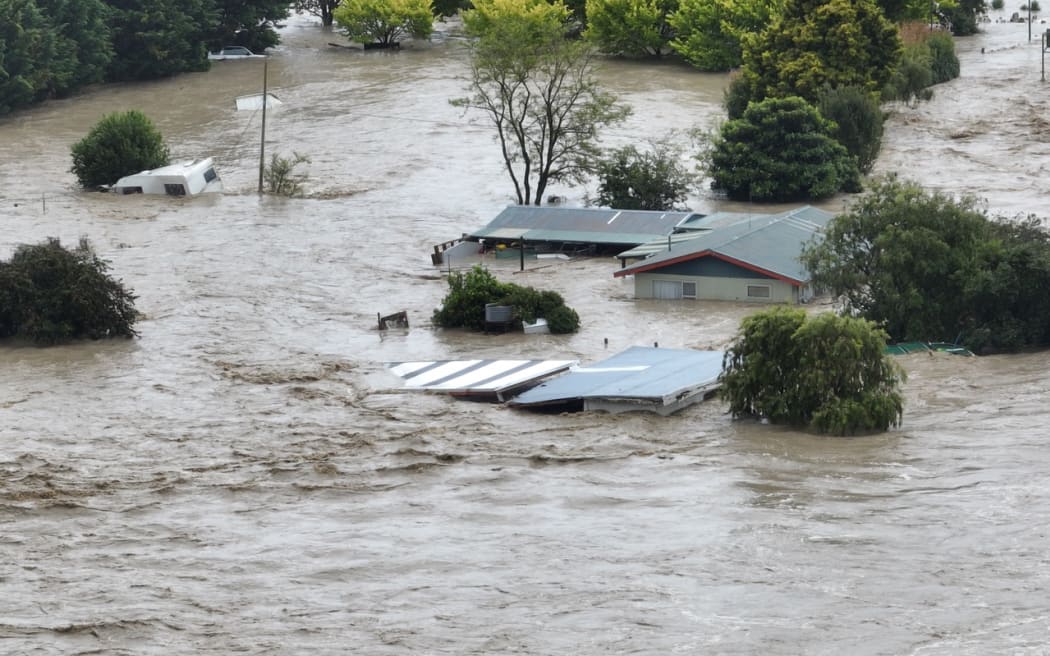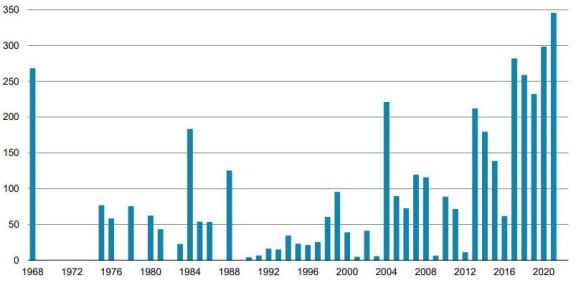
Flooding after the Ngaruroro River in Hawke’s Bay burst its banks throughout Cyclone Gabrielle.
Photograph: Provided / Dawson Bliss
A brand new Treasury report says New Zealand’s financial system as a complete is resilient and well-placed to climate the local weather change storm.
Nonetheless it mentioned the “modest” change predicted to gross GDP within the coming many years masked the massive impression it could have on some sectors and households, and one professional is questioning its conclusions altogether, saying it’s radically underestimating the prices.
Chopping emissions to fulfill New Zealand’s local weather targets could trigger some sectors to shrink and even disappear, significantly these whose solely solution to scale back emissions is by lowering output.
Agriculture, forestry, fisheries and tourism have been significantly uncovered, as have been the areas the place these industries dominate or the locations significantly weak to flooding, similar to Southland, Tai Rāwhiti, Northland, Waikato and the West Coast.
Poorer folks could be disproportionately affected, as would Māori, the report mentioned.
The findings come from the Local weather Financial and Fiscal Evaluation Evaluation 2023 report by Treasury and the Ministry for the Setting.
It’s the first time Treasury has finished the sort of local weather report, and combines its personal evaluation with beforehand launched studies by the Local weather Change Fee, consultants and different businesses.
Treasury mentioned modelling of the general fiscal (authorities income and spending) danger from bodily issues like storms, flooding and sea stage rise was not but out there, however it was more likely to be substantial and develop over time.
It mentioned this report was finished earlier than Cyclone Gabrielle and different main flooding occasions this 12 months.
Financial system and Crown books ‘resilient’
The report mentioned New Zealand was higher capable of adapt to the impacts of local weather change than many different international locations due to its sturdy establishments and monitor report of financial and monetary resilience.
It mentioned elevated storms and droughts might push up web core Crown debt by 3.77 % of GDP in 2061. For context, web debt is forecast to peak at 21.4 % of GDP in 2023/24, and in 2022 the federal government pledged to maintain it beneath 30 %.
Treasury’s preliminary modelling reveals the impression of accelerating droughts would trigger GDP to be 0.5 % decrease in 2061, and larger floods and storms would make GDP 0.7 % decrease – not far off the blow to the financial system from the 1997/98 drought.
The evaluation considers solely two particular forms of excessive climate occasions in isolation, and doesn’t embrace sea stage rise or temperature will increase.
The impression on GDP from making emissions cuts wanted to met local weather targets beneath most eventualities was not anticipated to be a “materials departure from enterprise as ordinary”.
The Local weather Change Fee has beforehand estimated that assembly the emissions discount targets would lead to GDP being 1.2 % decrease in 2050.
It mentioned it could possible additionally require an additional $38 billion of capital funding.
Who can be most affected?
The report mentioned the “modest” change to GDP ranges masks how massive an impression it should have on some sectors and households.
Some sectors could shrink and even disappear, significantly these whose solely solution to scale back emissions is by making or doing much less.
Agriculture, forestry, fisheries and tourism are significantly uncovered given their direct dependence on climate-sensitive pure assets.

Areas similar to Southland, Tai Rāwhiti, Taranaki and the West Coast, whose economies have been reliant on emissions-intensive industries (similar to agriculture, heavy manufacturing, meals manufacturing, and extraction and distribution), could be most affected.
Rising prices of meals and gasoline pushed by the Emissions Buying and selling Scheme have been more likely to disproportionately have an effect on lower-income households. Māori have been particularly weak – they’re over-represented in lower-income households and usually tend to work in high-emitting sectors.
Households close to the coast and in flood plains have been at larger danger, and confronted paying extra for his or her insurance coverage or not with the ability to get it in any respect.
Attempting to chop emissions extra rapidly than at the moment deliberate, and the finite quantity of land out there to plant timber to soak up carbon, have been anticipated to drive larger detrimental impacts on GDP.
Nonetheless, the report famous that hotter temperatures could also be of some profit to New Zealand farmers in comparison with different international locations. And it mentioned there have been improved well being and atmosphere advantages from slashing fossil fuels.
Influence on authorities’s books
The report mentioned the general route of impression on fiscal income was more likely to be detrimental – from each the bodily danger posed by local weather change, and due to the opportunity of barely decrease financial progress because of the change to a low-emissions financial system.
The report mentioned excessive climate occasions and sea-level rise have been anticipated to current the best dangers to the worth of the bodily belongings owned by the Crown. These included roads, colleges and hospitals, rail belongings and electrical energy infrastructure.
The prices from extra frequent and damaging storms have been more likely to improve over time, increasing New Zealand’s already vital pure hazard danger profile.
Modelling confirmed that sea-level rise of 30cm – anticipated to happen between 2045 and 2070 – might expose a further $6b value of buildings to a minimum of a 1 % probability of flooding in a given 12 months, past the $12.5b uncovered at present sea stage.
Different modelling confirmed that round 10,000 homes might develop into uninsurable by 2050 due to coastal flooding hazards from sea-level rise.
The federal government confronted having to pay for adaptation measures, potential monetary help for folks affected by droughts and floods, and elevated storms would additionally expose Crown belongings to larger danger.
Oblique fiscal prices have been more likely to come up because of adjustments to the tax base. There could be implications for transport-related prices and taxes, and thru environmental taxes, together with the NZ ETS.
The report cited NZIER analysis that local weather change might trigger a rise within the annual progress of the Crown legal responsibility for pure hazards from 5.3 % to as much as 5.7 % by way of to 2050.
Treasury evaluation confirmed assembly New Zealand’s worldwide pledge to chop emissions – referred to as Nationally Decided Contributions, or NDCs – which requires paying different international locations to make cuts on our behalf, will price wherever from $3.3b to $23.7b by 2030.
‘Little bit of a stretch’
Professor Ilan Noy, inaugural chair within the economics of disasters and local weather change at Victoria College, informed RNZ’s Morning Report on Tuesday the authors of the report have been “endeavor a mission that’s virtually unattainable to do” with out crystal balls.
“The instruments we’ve got are very, very imperfect, so I believe to anticipate that it’s going to accomplish that precisely is a little bit of a stretch. However I believe that the report does underestimate some points, some issues, and that is what I might emphasise.”
The primary drawback, Noy mentioned, was that New Zealand hoped to keep away from having to get rid of emissions by offsetting them with carbon permits purchased on the worldwide market.
“The issue with that’s that just about each nation on this planet has precisely the identical plan, so all people desires to purchase emission permits overseas,” he defined.
“Now, if everybody buys and nobody sells, we’ve got an issue. So we’re assuming that there’s a mysterious nation that may scale back its emissions much more than its targets after which promote the additional to all the opposite international locations on this planet, however that that mysterious nation I do not suppose exists. No, it isn’t life like to anticipate that we’ll try this.
“So there are two different the 2 methods to cope with that. One is to cut back our emission extra deeply than that – truly scale back our emissions – or simply not obtain the targets that we set ourselves. Neither of those are very appetising, I believe.”

Ilan Noy
Photograph: equipped
The price of buying credit might vary wherever between $3 billion and $23 billion, the report mentioned, noting “the longer term value of worldwide reductions is unsure”. Noy mentioned even the higher determine was not an enormous quantity to soak up over many years, however ” it may very well be a lot greater than that, if certainly what I am saying is true and no one goes to be promoting these or very, only a few international locations are going to be promoting these permits. So I am unsure that that these numbers are life like.
“And the issue is, proper, if we kind of persuade ourselves that it is all manageable and we are able to purchase these credit, then the incentives, the stress to really bodily lower emissions is doubtlessly decreased.”
He mentioned the Treasury report additionally seems to be at “numerous studies and analysis tasks” whose “numbers someway do not align very properly”.
“The issue right here is that this report is relying not on a unified and internally coherent physique of analysis that the Treasury has undertook. It takes numerous studies and analysis tasks and so forth which were finished through the years and tries to compile them collectively, however they don’t seem to be internally in keeping with one another.”
Nor are up-to-date, he mentioned, relying “closely on the report from 2018, which appeared on the earlier decade and sadly within the final 5 years, each single 12 months has damaged the report by way of excessive climate occasions”.
